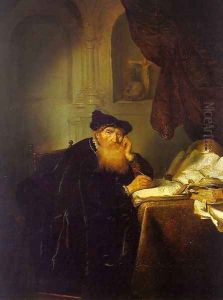Abraham van der Hecken Paintings
Abraham van der Hecken was a Dutch Golden Age painter, primarily known for his genre scenes and historical paintings. He was born in Antwerp in 1618 to a family of artists; his father was the painter Jan van der Hecken. Abraham's artistic training and early influences are not thoroughly documented, but it is likely that he received his initial training from his father.
Van der Hecken's work was characteristic of the period, focusing on detailed interior scenes, religious themes, and occasional portraits. His genre scenes often depicted everyday life with an emphasis on the interplay of light and shadow, a technique that was a hallmark of Dutch painting at the time. He was also known for his ability to capture the textures of different materials, from the sheen of metal objects to the softness of fabrics.
Abraham van der Hecken's career unfolded during a period when the Dutch Republic was experiencing unprecedented economic prosperity and cultural growth, known as the Dutch Golden Age. This was a time when art was flourishing, and there was a high demand for paintings from a growing middle class. Despite this, little is known about his professional life or patronage. He does not appear to have been a member of any artist's guild, which was unusual for the time and may have limited his commercial opportunities.
It is believed that van der Hecken spent the majority of his life in Antwerp and that he did not travel extensively, which was somewhat atypical for artists of his time. Many of his contemporaries traveled to Italy, for example, to study the works of the Renaissance masters, but there is no evidence that van der Hecken made such journeys.
Abraham van der Hecken died in 1655, at the age of 37. His relatively short life and the limited number of surviving works have made him a less well-known figure of the Dutch Golden Age, compared to his contemporaries like Rembrandt or Vermeer. Nonetheless, his paintings are appreciated for their contribution to the genre of scenes of everyday life and for their fine execution, which provides insight into the period's artistic practices and social conditions.
